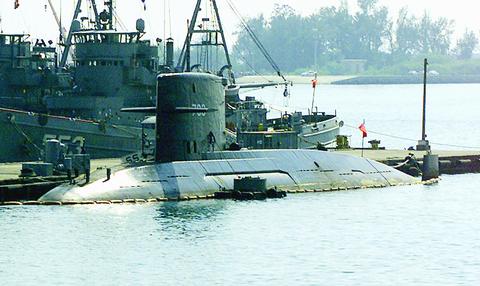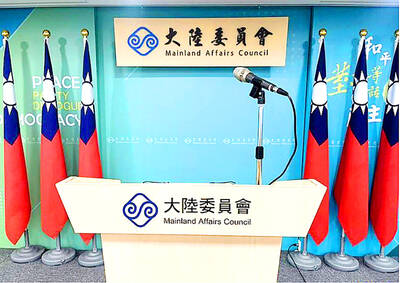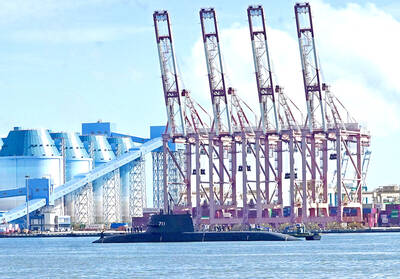The crew of Taiwan's Sea Tiger submarine went on combat alert after radars detected a suspicious object. Torpedo tubes were flooded and ready for firing.
It was a routine drill aboard the Dutch-made Zwaardvis class submarine, The Sea Tiger, and its identical sister vessel, the Sea Dragon -- Taiwan's only combat-ready submarines.

PHOTO: REUTERS
Taiwan has long sought to upgrade its feeble fleet of four submarines, which also includes a pair of Guppy IIs -- rusty relics of World War II.
But nobody has dared deliver the goods to Taiwan since China downgraded relations with the Netherlands from 1981 to 1984 over its sale of the two diesel-electric submarines.
China, for its part, maintains a fleet of about 60 to 70 submarines.
Only a handful are thought to be operational, but Beijing has spent billions of dollars on four Russian Kilo class diesel submarines that give it a clear edge over Taiwan, according to US officials.
"The two [Dutch] submarines are in excellent condition," said Peter Wang, security officer of the Sea Tiger, at a naval base in southern Taiwan. "We are well trained and ready to fight. But we need more."
Taiwan's pleas for more submersibles had been left unanswered until earlier this year when US President George W. Bush agreed to sell eight diesel submarines in the biggest arms sale package in more than a decade.
But months have passed and it is unclear how the US will provide the vessels because it builds only nuclear submarines, and not the promised diesel ones.
Experts have said the submarines would likely be Dutch-designed and German-built boats equipped with US technology and supplied under a deal brokered by the US.
But the Netherlands and Germany have denied they would export or build submarines for Taiwan.
"We are still talking with the US side," said a Taiwanese naval officer who declined to be identified.
Chung Chien, a military expert who teaches at the Armed Forces University, said the US would likely help the nation build the vessels themselves.
A spokesman for Taiwan's state-run China Shipbuilding Corp said the firm could build the submarines -- with help.
Washington also plans to sell Taiwan four Kidd class destroyers and a dozen P-3 "Orion" anti-submarine aircraft.
But the submarines will make the biggest splash.
Officials and analysts agree Taiwan's biggest threat is not conventional warfare, but a Chinese missile attack or naval blockade.
With submarines, Taiwan could thwart an amphibious attack from China and give its navy an offensive capability.
Beijing argues submarines are not defensive weapons and should not be provided under the US Taiwan Relations Act, which obliges Washington to provide Taiwan with enough arms to defend itself.
New submarines could undermine China's three main options for retaking Taiwan -- amphibious assault, naval blockade and missile strikes, defense analysts say.
In combination with Taiwanese jet fighters, they could scupper an amphibious assault launched from China's east coast.
But more worrying for Beijing, the submarines could eventually be used to launch cruise missiles to respond to or pre-empt a missile attack from China.
Commander Wang, who has served aboard the Sea Tiger since shortly after Taiwan took delivery of the two vessels in 1987, said he was confident the sub would soon get undersea companions.
"We have overcome the biggest obstacle -- the US has said yes. I have never felt so confident."

CHIP WAR: The new restrictions are expected to cut off China’s access to Taiwan’s technologies, materials and equipment essential to building AI semiconductors Taiwan has blacklisted Huawei Technologies Co (華為) and Semiconductor Manufacturing International Corp (SMIC, 中芯), dealing another major blow to the two companies spearheading China’s efforts to develop cutting-edge artificial intelligence (AI) chip technologies. The Ministry of Economic Affairs’ International Trade Administration has included Huawei, SMIC and several of their subsidiaries in an update of its so-called strategic high-tech commodities entity list, the latest version on its Web site showed on Saturday. It did not publicly announce the change. Other entities on the list include organizations such as the Taliban and al-Qaeda, as well as companies in China, Iran and elsewhere. Local companies need

CRITICISM: It is generally accepted that the Straits Forum is a CCP ‘united front’ platform, and anyone attending should maintain Taiwan’s dignity, the council said The Mainland Affairs Council (MAC) yesterday said it deeply regrets that former president Ma Ying-jeou (馬英九) echoed the Chinese Communist Party’s (CCP) “one China” principle and “united front” tactics by telling the Straits Forum that Taiwanese yearn for both sides of the Taiwan Strait to move toward “peace” and “integration.” The 17th annual Straits Forum yesterday opened in Xiamen, China, and while the Chinese Nationalist Party’s (KMT) local government heads were absent for the first time in 17 years, Ma attended the forum as “former KMT chairperson” and met with Chinese People’s Political Consultative Conference Chairman Wang Huning (王滬寧). Wang

CROSS-STRAIT: The MAC said it barred the Chinese officials from attending an event, because they failed to provide guarantees that Taiwan would be treated with respect The Mainland Affairs Council (MAC) on Friday night defended its decision to bar Chinese officials and tourism representatives from attending a tourism event in Taipei next month, citing the unsafe conditions for Taiwanese in China. The Taipei International Summer Travel Expo, organized by the Taiwan Tourism Exchange Association, is to run from July 18 to 21. China’s Taiwan Affairs Office spokeswoman Zhu Fenglian (朱鳳蓮) on Friday said that representatives from China’s travel industry were excluded from the expo. The Democratic Progressive Party government is obstructing cross-strait tourism exchange in a vain attempt to ignore the mainstream support for peaceful development

DEFENSE: The US would assist Taiwan in developing a new command and control system, and it would be based on the US-made Link-22, a senior official said The Ministry of National Defense is to propose a special budget to replace the military’s currently fielded command and control system, bolster defensive resilience and acquire more attack drones, a senior defense official said yesterday. The budget would be presented to the legislature in August, the source said on condition of anonymity. Taiwan’s decade-old Syun An (迅安, “Swift Security”) command and control system is a derivative of Lockheed Martin’s Link-16 developed under Washington’s auspices, they said. The Syun An system is difficult to operate, increasingly obsolete and has unresolved problems related to integrating disparate tactical data across the three branches of the military,